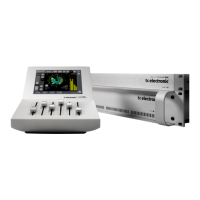110
lM6
Introduction
Since1998,TChasperformedlisteningtestsandevaluationofloudnessmodels;andthereforeholdsanextensive,
UniversalDatabaseofloudness,basedontenthousandsofassessments.Thedatabasecoversallsortsofbroadcast
material, music, commercials, feature film and experimental sounds, and is verfied against other independent studies.
Fig 1.
Left: DRT for consumers under different listening situations
Right: Peak level normalization means that material targeted low dynamic range platforms gets loud.
TheUniversalDatabaseisauthoritativefroman
academic as well as a practical point of view. It has been
indispensable when designing the LM6 meter, because it
providedthemissinglinkbetweenshort-termandlong-term
loudness,andenabledthestatisticallyfoundedUniversal
Descriptors of LM6 .
ThechartofDynamicRangeToleranceinFig1isa
side-effect of the studies mentioned: Consumers were
found to have a distinct Dynamic Range Tolerance (DRT)
specific to their listening environment. The DRT is defined
asaPreferredAveragewindowwithacertainpeaklevel
Headroom above it. The average sound pressure level,
which obviously is different from one listening condition to
another,hastobekeptwithincertainboundariesinorder
to maintain speech intelligibility, and to avoid music or
effects from getting annoyingly loud or soft.
Audio engineers instinctively target a certain DRT profile
when mixing, but because level normalization in broadcast
andmusicproductionisbasedonpeaklevelmeasures,
low dynamic range signatures end up the loudest as shown
bytheredlineinFig1,right.Audioproductionistherefore
trapped in a downwards spiral, going for ever decreasing
dynamicrange.Bynow,thepopmusicindustryis“rightof”
InFlightEntertainmentintheillustration.
LM6 offers a standardized option: The visualization of
loudness history and DRT in combination with long-term
descriptors from production onwards, is a transparent
andwellsoundingalternativetoourcurrentpeaklevel
obsession. Not only for music, but also in production for
broadcast or film. The engineer, who may not be an audio
expert,shouldbeabletoidentifyandconsciouslywork
with loudness developments within the limits of a target
distribution platform, and with predictable results when the
program is transcoded to another platform.
LM6thereforecolorcodesloudnesssoit’seasytoidentify
target level (green), below the noisefloor level (blue), or
loudevents(yellow),seeFig2.

